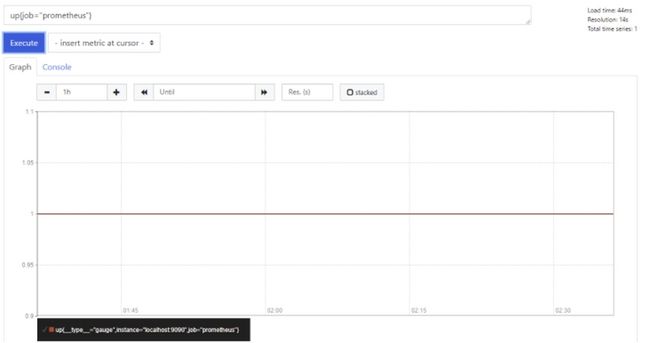prometheus中remote-write和remote-read的配置:
# store data to influxdb
remote_write:
- url: "http://10.21.1.74:8086/api/v1/prom/write?db=prometheus"
# read data from influxdb
remote_read:
- url: "http://10.21.1.74:8086/api/v1/prom/read?db=prometheus"remote-read可以让prometheus读取远程存储上的时序数据,扩展了本地存储。
prometheus在应对/query查询请求时,由fanoutStorage处理;
- fanoutStorage包含localStorage(本地TSDB)和remoteStorage(远程存储),它们均实现了查询接口;
- localStorage执行本地查询;
- remoteStorage通过HTTP执行远程查询;
- 将上述2个查询结果进行合并,返回给client;
demo演示
- prometheus配置remote-write和remote-read;
- 运行一段时间后:
停止prometheus: stop prometheus;
删除本地数据:delete prometheus/data目录;
启动prometheus: start promethesu;
上述操作模拟:本地存储宕机,使用远程存储的场景。
- 在prometheus UI上执行查询,可以得到历史数据(远程存储);
remote-read的代码
执行远程查询的入口代码:生成query,然后发送HTTP远程查询
// storage/remote/read.go
func (q *querier) Select(sortSeries bool, hints *storage.SelectHints, matchers ...*labels.Matcher) storage.SeriesSet {
if len(q.requiredMatchers) > 0 {
requiredMatchers := append([]*labels.Matcher{}, q.requiredMatchers...)
for _, m := range matchers {
for i, r := range requiredMatchers {
if m.Type == labels.MatchEqual && m.Name == r.Name && m.Value == r.Value {
// Requirement matched.
requiredMatchers = append(requiredMatchers[:i], requiredMatchers[i+1:]...)
break
}
}
}
}
// 加label
m, added := q.addExternalLabels(matchers)
// 生成查询
query, err := ToQuery(q.mint, q.maxt, m, hints)
// HTTP client发起远程查询
res, err := q.client.Read(q.ctx, query)
return newSeriesSetFilter(FromQueryResult(sortSeries, res), added)
}client对象的构造:每个remote有一个client,使用其配置的URL/HttpConfig构造
//storage/remote/storage.go
func (s *Storage) ApplyConfig(conf *config.Config) error {
for _, rrConf := range conf.RemoteReadConfigs {
c, err := newReadClient(name, &ClientConfig{
URL: rrConf.URL,
Timeout: rrConf.RemoteTimeout,
HTTPClientConfig: rrConf.HTTPClientConfig,
})
queryables = append(queryables, NewSampleAndChunkQueryableClient(
c,
conf.GlobalConfig.ExternalLabels,
labelsToEqualityMatchers(rrConf.RequiredMatchers),
rrConf.ReadRecent,
s.localStartTimeCallback,
))
......
}
......
}发起HTTP远程查询请求:
- HTTP request: 先用protobuf序列化,再用snappy压缩;
- HTTP response: 先用snappy解压缩,然后再用protobuf反序列化;
//storage/remote/client.go
// Read reads from a remote endpoint.
func (c *client) Read(ctx context.Context, query *prompb.Query) (*prompb.QueryResult, error) {
req := &prompb.ReadRequest{
Queries: []*prompb.Query{
query,
},
}
// protobuf序列化
data, err := proto.Marshal(req)
// snappy压缩
compressed := snappy.Encode(nil, data)
// 发送HTTP POST
httpReq, err := http.NewRequest("POST", c.url.String(), bytes.NewReader(compressed))
httpReq.Header.Add("Content-Encoding", "snappy")
httpReq.Header.Add("Accept-Encoding", "snappy")
httpReq.Header.Set("Content-Type", "application/x-protobuf")
httpReq.Header.Set("User-Agent", userAgent)
httpReq.Header.Set("X-Prometheus-Remote-Read-Version", "0.1.0")
ctx, cancel := context.WithTimeout(ctx, c.timeout)
defer cancel()
httpReq = httpReq.WithContext(ctx)
// 发送request
httpResp, err := c.client.Do(httpReq)
compressed, err = ioutil.ReadAll(httpResp.Body)
//返回的结果,先snappy解压缩
uncompressed, err := snappy.Decode(nil, compressed)
var resp prompb.ReadResponse
// 再protobuf反序列化
err = proto.Unmarshal(uncompressed, &resp)
return resp.Results[0], nil
}
